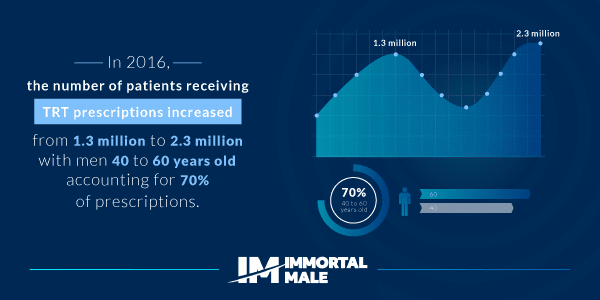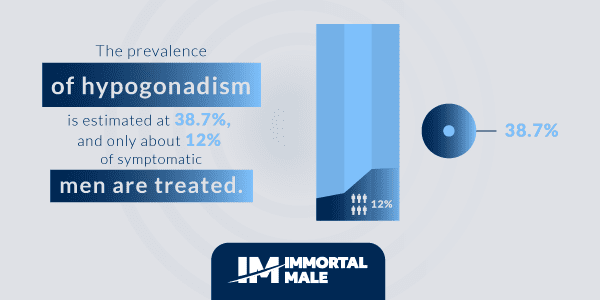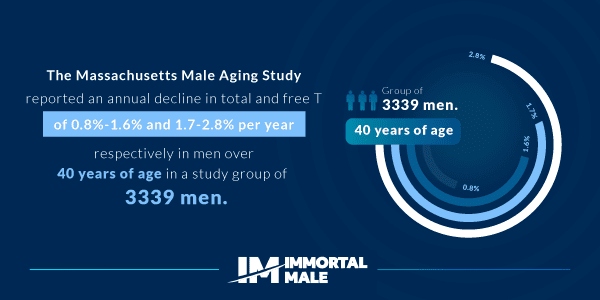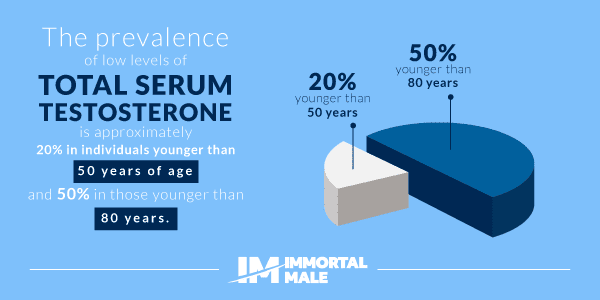
Learn everything you need to know about ‘What is TRT’ and how Immortal Male can help with low testosterone.
Are you or a loved one looking looking into testosterone replacement therapy but find yourself asking, “what is TRT?” Read our guide to learn about the TRT process and how to receive help today.
Testosterone is often incorrectly associated with negative behaviors, such as aggression, but the truth is that testosterone is a complex and essential tool for the human body. In males especially, testosterone is necessary for the growth and maintenance of masculine characteristics.
Testosterone is a hormone found in both men and women created from cholesterol in the body. In men, testosterone is the major sex hormone and has several vital functions, including:1
As men age, the amount of testosterone produced in the body begins to decline steadily.2 An estimated 25% of men experience low testosterone with increased age, with over one-third of men older than forty-five experiencing levels of testosterone lower than average.3
Testosterone: An Overview
Testosterone replacement therapy is one of the available treatment options for low testosterone. TRT is the process of returning levels of testosterone in the body to a natural concentration through external sources of testosterone. It’s important for anyone considering low testosterone treatment options to learn about the advantages of testosterone replacement therapy and the issues it is intended to treat.
Low testosterone is common, causing many men to experience the symptoms of male testosterone deficiency, also known as hypogonadism.4 Testosterone replacement is an effective treatment for individuals who test for and show signs and symptoms of low testosterone or are professionally diagnosed with hypogonadism. As many as 2.8% of men aged forty years and older in the United States receive testosterone replacement therapy per year.5
Hypogonadism is an increasingly more common condition, affecting 20% to 40% of older men.6 When hypogonadism occurs in older men, it is often referred to as late onset hypogonadism (LOH) or andropause. Hypogonadism more prevalent in men with underlying conditions such as obesity, diabetes, asthma, prostatic disease, hypertension, and chronic obstructive pulmonary disease (COPD).6
In men, hypogonadism presents itself as the gonads or testes improperly functioning, thus inhibiting production of testosterone. Hypogonadism can also lead to improper sperm counts. An individual can either be born with hypogonadism, or experience it later in life, often as a result of injury or infection.
Testosterone replacement is intended for individuals who have been professionally diagnosed with hypogonadism. Diagnosing low testosterone requires a serum testosterone of less than 300 ng/mL and that the individual is experiencing the specific symptoms of low testosterone.7
Low Testosterone and Male Health
Common signs and symptoms of low testosterone include:

There is an array of testosterone replacement methods available, including tablets, injections, transdermal systems, pellets, and buccal preparations. The wide variety of TRT medicine delivery systems allows patients to achieve the benefits of testosterone therapy with a method they are comfortable using. A study from the National Library of Medicine found that patient satisfaction among injections (73%), pellets (70%), and gels (68%) were relatively similar, showing that multiple options yield positive results.8
A key part of learning about TRT is familiarizing oneself with the types of testosterone replacement therapy options. Popularly prescribed TRT delivery methods are discussed in detail below:
Testosterone replacement therapy injections are administered as intramuscular injections, with doses occurring every one to two weeks.9 Administration of testosterone replacement therapy injections may occur independently at home or require visiting a provider for each dose. Selecting the best testosterone injection option requires a conversation between the patient and their provider to determine a treatment plan that meets the patient’s needs and expectations.
The benefits of testosterone therapy begin taking shape several months after the first injection. For the best testosterone injection results, the patient must stick to their schedule and maintain regular administration.9
Testosterone replacement therapy gel is a widely used and popular form of TRT medication. The gel is applied by the patient to the skin of the arms, torso, or thighs, making this a relatively easy type of testosterone to manage. Testosterone replacement therapy gel has shown to be a highly effective method for the management of symptoms of hypogonadism. When comparing testosterone gel vs. injection, it is important to note that the gel requires greater care from the patient to reduce opportunities for skin-to-skin transfer with others.9
There is currently one testosterone patch available in the United States. The patch is an effective type of testosterone replacement therapy for men; however, one-third of men reported high rates of skin irritation. When comparing the testosterone patch vs. gel, the patch will protect patients from unintentional skin transfer, which can be desirable for patients with female partners or children.9
Testosterone pellet implants are placed in the fat of the lower abdomen, buttocks, or thighs by a medical professional. This option requires visiting a provider’s office every three to six months for pellet renewal, as a sterile technique is needed for pellet insertion. A benefit of this method is that doses are infrequently delivered, which may be desirable for patients with busy or uncertain schedules. Furthermore, one study found that 86% of men were satisfied with this testosterone treatment method and experienced symptom improvement.9
Nasal gel availability is limited in clinical settings, as it has a high potential for nasal and gingival irritation and lacks comprehensive studies to confirm the safety of this testosterone delivery type. Nonetheless, two trials showed that 90% of patients achieved normal levels of serum testosterone after ninety days, indicating promise as a good option for patients who are unable to utilize the other types of testosterone offered.9
Oral testosterone pills yield low serum testosterone concentrations, but studies are currently in progress to enhance their effectiveness.9 Patients must take oral pills with a fat-containing meal for this testosterone replacement method to receive its full benefits. Note that while oral pills are a safe option that offers continued patient monitoring, they can be potentially toxic to the liver.10
Bioidentical hormone therapy involves the utilization of natural sources, typically plants, to create a chemically identical hormone. Delivering a chemically identical hormone to the body is generally considered safer than the alternative, synthetically designed hormone options. Bioidentical hormone therapy is a great choice for patients seeking the health benefits of TRT.
Testosterone Replacement Therapy: Overview of Options


Low testosterone should only be diagnosed by medical professionals. Diagnostic criteria for hypogonadism include experiencing specific symptoms, such as low libido, fatigue, erectile dysfunction, and decreased muscle mass, and testing with a low testosterone serum count by an accredited laboratory.
Hypogonadism is characterized by many symptoms and can frequently be mistaken for or overlap with other conditions, such as depression or sleep apnea, making diagnosis difficult.3 So, any person searching for relief from hypogonadism-related symptoms should seek care from a team of highly educated individuals for a proper diagnosis.
The blood test for low testosterone measures the amount of testosterone present in serum. Low testosterone is diagnosed at a serum testosterone concentration of less than 300 ng/dL.25
Hypogonadism can only be accurately diagnosed with laboratory findings of low total serum testosterone levels. For healthy men, total serum testosterone should be greater than 300 ng/dL, usually above 500 ng/dL. For those with low testosterone, the criteria for a hypogonadism diagnosis include total serum testosterone levels of less than 300 ng/dL in combination with at least one symptom of hypogonadism, such as decreased libido, depression, and loss of muscle mass and strength.25

Immortal Male offers a comprehensive testosterone replacement therapy program that accounts for the whole health and well-being of each patient. From the start, patients are connected with a team of medical professionals ready to help through every step of the process.
Starting testosterone replacement therapy for men with Immortal Male is simple. Everything begins with the At-Home Hormone Test Kit, which can be ordered from the Immortal Male website.
At Immortal Male, patient well-being comes first. For a personalized diagnosis and treatment plan, the process begins with a complete hormone panel tested by an accredited laboratory and access to a team of licensed physicians. The hormone test provides physicians with a baseline to help them develop a treatment protocol to yield optimal results.
Patients are treated to the very best in personalized care throughout the entire treatment process. The More Life Membership offers a customized treatment program with the appropriate medications to optimize and maintain overall health. Patients have access to highly qualified professionals prepared to answer question, “what is TRT?” and adjust treatment plans when the need arises.
The concierge team is available to answer questions and concerns throughout the TRT treatment process.
When the More Life Membership package arrives, patients can breathe a sigh of relief. Longevity, quality of life, and whole-body health start now. With the Immortal Male treatment program, restoration and fulfillment can finally be achieved.
If you want to learn more about what TRT is, contact Immortal Male today.
Immortal Male is an online clinic that helps men optimize their hormones.
As part of your membership and as medically indicated, physicians prescribe medications, and recommend supplements that are delivered to you from the comfort of your home.